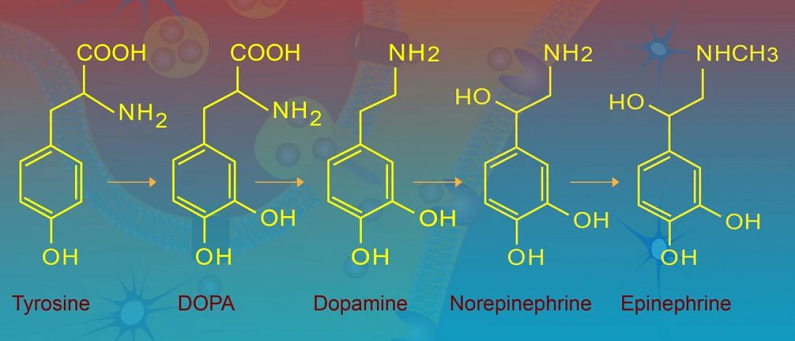
Attention-Deficit Hyperactivity Disorder (ADHD) is a common neurodevelopmental disorder, affecting millions worldwide. Characterized by symptoms like inattention, hyperactivity, and impulsivity, ADHD can significantly impact daily life. Traditionally managed through medication and therapy, there’s a growing interest in alternative and complementary approaches, particularly in the realm of nutrition. Among these, N-Acetyl L-Tyrosine (NALT), a modified form of the amino acid L-Tyrosine, is emerging as a potential ally in the management of ADHD symptoms. Here we explore the mechanism of NALT in dopamine production and its efficacy compared to traditional ADHD treatments.
Contents
Understanding N-Acetyl L-Tyrosine (NALT)
N-Acetyl L-Tyrosine, commonly known as NALT, is an intriguing supplement, especially in the context of cognitive health and disorders like ADHD. To appreciate its potential role, it’s essential to delve into what NALT is, how it functions in the brain, and how it differs from its parent compound, L-Tyrosine.
Chemical Composition and Properties of N-Acetyl L-Tyrosine (NALT)
NALT is a modified version of the amino acid L-Tyrosine, which is naturally produced in the body from another amino acid called phenylalanine. NALT stands out due to the addition of an acetyl group, which alters its properties. This acetylation enhances the compound’s solubility and bioavailability, meaning it can be more readily absorbed and utilized by the body compared to L-Tyrosine. This increased bioavailability is crucial, as it suggests that NALT can more effectively cross the blood-brain barrier, a vital factor for influencing brain function.
NALT Mechanism of Action in the Brain
The primary role of NALT in the brain revolves around its influence on neurotransmitters, the brain’s chemical messengers. Specifically, NALT is a precursor to dopamine, a key neurotransmitter involved in mood regulation, motivation, attention, and motor control. In individuals with ADHD, dysregulation of dopamine pathways is often observed, leading to the disorder’s characteristic symptoms. By providing the body with more of the raw material needed to produce dopamine, NALT potentially helps in normalizing these pathways, thereby mitigating symptoms of ADHD.
NALT Versus L-Tyrosine: What’s the Difference?
While NALT and L-Tyrosine are closely related, their differences are significant, especially in therapeutic contexts. The main advantage of NALT lies in its enhanced absorption and ability to cross the blood-brain barrier more efficiently than L-Tyrosine. This means that NALT can potentially have a more direct and potent effect on brain chemistry. However, it’s important to note that while studies have shown promising results regarding NALT’s efficacy, more research is needed to fully understand its benefits and optimal usage, particularly in relation to ADHD [1].

The Link Between NALT and ADHD
The potential connection between N-Acetyl L-Tyrosine (NALT) and Attention-Deficit Hyperactivity Disorder (ADHD) is a topic of considerable interest in the field of cognitive health.
NALT’s Role in Dopamine Production
The primary link between NALT and ADHD lies in dopamine, a neurotransmitter crucial for cognitive processes like attention, motivation, and memory. ADHD is often associated with impaired dopamine regulation, leading to the disorder’s hallmark symptoms of inattention, hyperactivity, and impulsivity. NALT, being a precursor to dopamine, potentially aids in balancing these dopamine levels. By providing the brain with the necessary components to produce dopamine, NALT could help in normalizing the neurotransmitter activity that is often disrupted in individuals with ADHD, thereby alleviating some of the symptoms.
Impact of NALT on ADHD Symptoms
The theoretical impact of NALT on ADHD stems from its potential to enhance dopamine synthesis. Improved dopamine function can positively influence focus, attention span, and impulse control, which are key challenges for individuals with ADHD. Early research and anecdotal evidence suggest that supplementing with NALT may lead to improvements in these areas. However, it’s important to note that the response to NALT can vary widely among individuals, and its efficacy may depend on a multitude of factors including the severity of symptoms, individual biochemistry, and concurrent treatments [2].
Review of Relevant Research Studies Involving NALT and ADHD
While the research on NALT specifically targeting ADHD is still emerging, several studies have shed light on its broader cognitive effects. These studies typically focus on cognitive enhancement, stress reduction, and the improvement of neurochemical pathways related to attention and focus.
It’s crucial to critically examine these studies, understanding their methodologies, sample sizes, and the context in which NALT was used. This review helps in piecing together a more comprehensive picture of how NALT might be beneficial in the context of ADHD. However, more targeted research is needed to draw definitive conclusions about NALT’s efficacy and optimal use in ADHD treatment.
Advantages of NALT in ADHD Management
Exploring the advantages of N-Acetyl L-Tyrosine (NALT) in managing Attention-Deficit Hyperactivity Disorder (ADHD) reveals its potential as a complementary treatment option.
Potential Benefits of NALT Over Traditional ADHD Medications
One of the key advantages of NALT in ADHD management lies in its nature as a nutritional supplement, contrasting with the pharmacological approach of traditional ADHD medications. Unlike stimulant medications commonly used in ADHD treatment, which can have significant side effects and may be unsuitable for some individuals, NALT offers a more natural approach. It works by supplementing a naturally occurring amino acid to potentially improve cognitive functions.
This aspect makes NALT an appealing alternative or adjunct for those seeking less invasive treatment methods. Moreover, NALT’s role in enhancing dopamine production could address some of the core neurological issues in ADHD without the risk of tolerance or dependency associated with some traditional medications [3].
Side Effects and Safety Profile of NALT
NALT is generally well-tolerated and considered safe when used in appropriate doses. The side effects are typically mild and may include gastrointestinal discomfort, headaches, or fatigue. These are significantly less severe compared to the potential side effects of conventional ADHD medications, such as appetite suppression, sleep disturbances, and mood changes.
However, it’s important to approach NALT supplementation with caution, especially when combined with other medications or in individuals with certain medical conditions. Consulting with a healthcare professional before starting NALT supplementation is always recommended to ensure safety and appropriateness.
NALT Dosage and Administration Guidelines
The optimal dosage of NALT for ADHD management is not universally established and may vary based on individual needs and responses. Generally, the recommended starting dose is lower, gradually increasing to gauge effectiveness and tolerance. It is crucial for users to adhere to recommended dosages and to consult with healthcare professionals for personalized guidance.
Regular monitoring and adjustments based on individual response are key to finding the most effective and safe dosage. Additionally, considering the timing of administration, such as taking NALT in the morning or before activities that require enhanced focus, can optimize its benefits [4].

Integrating NALT into ADHD Treatment Plans
Incorporating N-Acetyl L-Tyrosine (NALT) into treatment plans for Attention-Deficit Hyperactivity Disorder (ADHD) necessitates a comprehensive approach. This involves considering dietary and lifestyle factors, understanding how NALT interacts with other supplements or medications, and monitoring treatment progress.
Diet and Lifestyle Considerations of Enhance NALT
The effectiveness of NALT in managing ADHD symptoms can be influenced by overall diet and lifestyle choices. A balanced diet rich in nutrients is foundational for cognitive health and can augment the benefits of NALT. Foods high in protein, omega-3 fatty acids, and complex carbohydrates are particularly beneficial for brain health.
In addition to dietary considerations, lifestyle factors such as adequate sleep, regular physical activity, and stress management techniques should be incorporated into the treatment plan. These elements can support the overall effectiveness of NALT, as they contribute to improved brain function and general well-being [5].
Synergistic Effects of NALT with Other Nootropics or Supplements
NALT can be part of a broader supplement regimen targeting ADHD. Its effects might be enhanced when combined with other nootropics or supplements that support brain health. For instance, omega-3 supplements, magnesium, and zinc have been studied for their potential benefits in ADHD.
It’s important to consider the synergistic effects of these supplements, as they can work together to improve cognitive function and symptom management. However, it’s crucial to consult with a healthcare professional before combining supplements to avoid potential interactions and ensure optimal dosing.
Monitoring and Adjusting NALT-based ADHD Treatment
Effective integration of NALT into an ADHD treatment plan requires ongoing monitoring and adjustment. Regular assessments of symptom changes, side effects, and overall well-being are essential to determine the effectiveness of the supplement. Adjustments in dosage or the combination of supplements may be necessary based on individual response and tolerance. Communication with healthcare providers is key in this process, ensuring that the treatment plan remains tailored to the individual’s needs and is aligned with their overall health goals.
References
[1] Does L-Tyrosine Help ADHD Symptoms?
[2] Can L-tyrosine help with ADHD?
[3] Tyrosine Supplements for ADHD Symptoms
[4] Can L-Tyrosine Help ADHD Symptoms?
[5] How Nutrition Harmonizes the ADHD Brain

